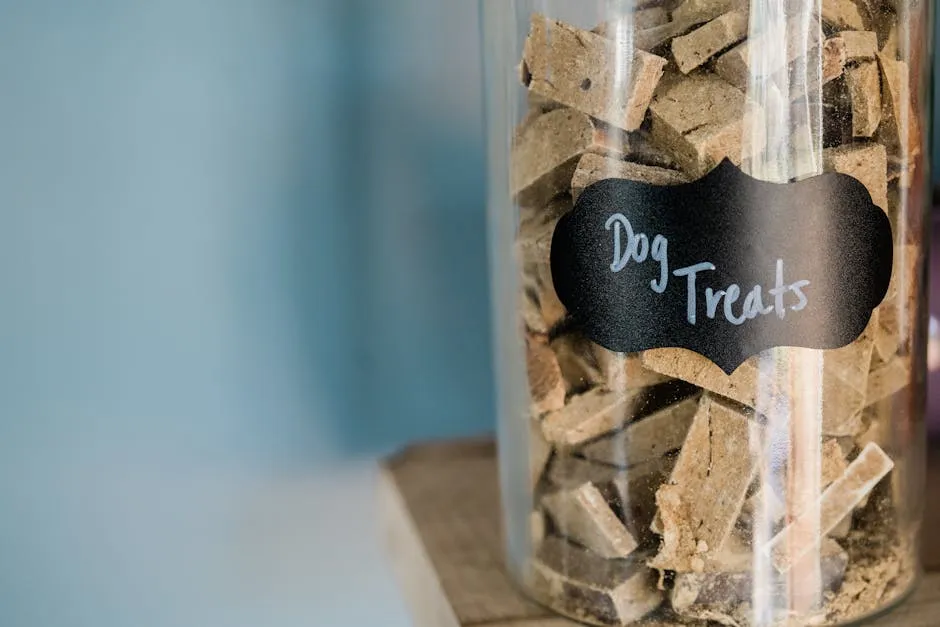Introduction
In a world filled with choices, picking the right dog food can feel like navigating a minefield. Do you go for grain-free, high-protein, or organic? And what on earth does “complete and balanced” really mean? Just like humans, dogs have their own unique dietary needs, and understanding them is the key to keeping your furry friend healthy and happy.
Many dog owners find themselves overwhelmed by the variety of options available. With every brand boasting the best ingredients, it’s easy to feel lost. Fear not! This guide is here to help you decode the complexities of dog food. After all, your pup deserves the best nutrition possible. Speaking of good nutrition, check out Royal Canin Dry Dog Food for tailored formulas that meet specific breed needs!
When considering your dog’s diet, think of their age, size, and activity level. Puppies need more protein for growth, while senior dogs might require fewer calories and joint support. The right food can make a world of difference in your dog’s well-being.
Reading dog food labels can feel like deciphering a secret code. What does “meat by-products” really mean? Is corn a villain or a hero? Don’t sweat it! We’ll break it all down so you can make informed choices for your furry companion. And for those who love a bit of variety, consider Hill’s Science Plan Dry Dog Food for health-focused options!
Whether you’re a first-time dog owner or a seasoned pro, this guide will help you navigate the dog food aisle with confidence. From kibble to canned food, we’ll cover everything you need to know. So grab a treat for your pup, and let’s get started on this tasty adventure!

Summary of Key Points
Choosing the right dog food is crucial for your dog’s health and well-being. This article will explore:
- The different types of dog food, including dry, wet, raw, and homemade options.
- How to read and understand dog food labels.
- Nutritional needs based on dog age, size, and activity level.
- Popular dog food brands and their unique offerings.
- Tips for transitioning between dog foods without upsetting your pup’s stomach.
- Common misconceptions and the truth about certain dog food ingredients.
By the end of this guide, you’ll be equipped to make informed decisions about your dog’s diet, helping them thrive like never before! And while you’re at it, don’t forget to check out Pedigree Wet Dog Food for a delicious option your dog will love!
Types of Dog Food
Choosing the right type of dog food can be as tricky as teaching a cat to fetch. With so many options available, it’s essential to understand what each type offers. Here’s a breakdown to help you make the best choice for your furry friend.
Dry Dog Food
Dry dog food, often called kibble, is a popular choice among pet owners. It boasts a variety of benefits that make it a convenient option. One of the standout advantages is dental health. The crunchy texture of kibble helps reduce plaque and tartar buildup. Think of it as your dog’s version of brushing their teeth—minus the toothpaste!
Convenience is another major perk. Dry food has a long shelf life, making it perfect for busy pet parents. You can scoop, pour, and serve without worrying about spoilage. Plus, it’s easy to measure portions, which helps in maintaining your dog’s ideal weight. And for those who want to keep things tidy, a Pet Food Storage Container can help keep your dog’s food fresh!
Brands like Royal Canin and Hill’s Science Plan are well-known for their dry food offerings. Royal Canin tailors its formulas to specific breeds, ensuring every pup gets the nutrition they need. Hill’s Science Plan focuses on health and wellness, providing options for sensitive stomachs and skin.

Wet Dog Food
Wet dog food comes in cans or pouches and is often more palatable for picky eaters. The high moisture content not only makes it delicious but also helps keep your dog hydrated. This is particularly beneficial for dogs that don’t drink enough water—think of it as a tasty hydration boost!
One of the biggest draws of wet food is its aroma. Dogs go wild for the scent of moist food, making mealtime a delightful experience. Brands like Pedigree and Butternut Box offer a variety of formulations, including grain-free options and recipes tailored for different life stages. For instance, Butternut Box Wet Dog Food specializes in fresh, human-grade ingredients, ensuring your dog enjoys only the best.
For example, Pedigree’s Chopped Ground Dinner creates a savory feast that even the fussiest dogs can’t resist. Butternut Box specializes in fresh, human-grade ingredients, ensuring your dog enjoys only the best.

Raw Dog Food
Raw dog food, or “BARF” (biologically appropriate raw food), is a trend that has gained traction among health-conscious pet owners. Advocates claim that raw feeding can lead to shinier coats, healthier teeth, and increased energy levels. It’s like a raw diet for dogs—just without the trendy Instagram posts!
However, transitioning to a raw diet isn’t without its risks. There’s a potential for nutritional imbalances and bacterial contamination. Before switching, consult your vet to ensure it’s a safe option. Brands like Open Farm and Stella & Chewy’s offer freeze-dried raw options that simplify the process. They provide balanced recipes that make raw feeding easier and safer. If you’re curious about raw feeding, give Open Farm Raw Dog Food a try!
Homemade Dog Food
Making dog food at home can be a rewarding experience. It allows you to control the ingredients, ensuring your pup gets a nutritious, balanced meal. However, it’s important to strike a balance. Homemade meals must meet your dog’s nutritional needs to avoid deficiencies.
Essential nutrients to include are proteins, healthy fats, carbohydrates, vitamins, and minerals. Lean meats, vegetables, and whole grains are all excellent choices. But be careful! Ingredients like onions, garlic, and chocolate are harmful to dogs.

If you’re considering homemade dog food, consult a veterinarian or a pet nutritionist. They can help you create a balanced meal plan tailored to your dog’s specific needs, ensuring they thrive without the risk of nutritional gaps. You can find some great recipes in our healthy homemade dog food recipes for senior dogs article.
If you’re interested in making your dog food at home, consider checking out our homemade dog food recipes for some delicious options!
Understanding these types of dog food will help you choose the best option for your canine companion. Each type has its strengths and weaknesses, so consider your dog’s preferences, dietary needs, and your lifestyle when making a decision. Happy feeding!

Senior Dogs
As your dog ages, their nutritional needs change. Senior dogs often require adjustments to their diet for optimal health. Here’s what to consider when feeding your golden oldie.
Adjustments
First off, lower calories are crucial. Senior dogs tend to be less active. Reducing calorie intake helps prevent obesity and related health issues. Think of it as helping your dog maintain a healthy waistline—no one wants to be a chubby pup!
Joint support is another important factor. Aging can lead to joint stiffness and discomfort. Look for dog foods that contain glucosamine and chondroitin. These ingredients can help keep your dog’s joints in tip-top shape. For an extra boost, consider adding Glucosamine Supplements for Dogs to your dog’s diet!
Specific dietary needs also come into play. Some senior dogs may develop sensitivities or health conditions. For example, food allergies or digestive issues can arise. In these cases, a hypoallergenic diet can be beneficial. Always consult your vet for personalized recommendations.
Recommended Products for Senior Dogs
When it comes to feeding your senior dog, several products stand out. Brands like Hill’s Science Plan offer tailored formulas, such as Hill’s Science Plan Mature Adult. This food is crafted for older dogs, combining essential nutrients with lower calories.

Royal Canin also has a Senior Consult formula, which focuses on joint health. Its blend of antioxidants supports a strong immune system. Plus, it’s designed to be palatable for even the pickiest eaters.
For those looking for grain-free options, consider Orijen’s Senior Dog Food. It’s packed with protein and made from fresh ingredients. This recipe helps maintain muscle mass without the extra calories. You can explore more about grain-free options in our article on grain-free dog food alternatives for sensitive stomachs. And if your pup loves to snack, don’t forget to stock up on Dog Dental Chews for a tasty treat that promotes dental health!
If you’re looking for grain-free options for your senior dog, check out our grain-free dog food alternatives for more information.
Finally, Blue Buffalo’s Life Protection formula for seniors offers a balanced diet. It contains whole grains, real meat, and essential vitamins. This option caters to dogs needing a bit of everything without extra calories. And while you’re at it, why not grab a Dog Bowl Set to make mealtime even more enjoyable?
In summary, adjusting your senior dog’s diet can greatly enhance their quality of life. With the right products, you can ensure they enjoy their golden years to the fullest!

Tips for Transitioning Dog Food
Switching your dog’s food can feel like a high-stakes game of musical chairs. One wrong move and—bam!—you’ve got a tummy ache on your hands. But fear not! Here’s a simple step-by-step guide to help you navigate this transition smoothly and keep those tails wagging.
1. Start Slow
Begin by mixing the new food with your dog’s current food. A good ratio is 25% new food to 75% old food. This gradual mix helps your pup’s digestive system adjust without turning meal times into a gastrointestinal drama.
2. Gradually Increase the New Food
After a few days, increase the new food to 50%, keeping the old food at 50%. Continue this for another few days to a week. Monitor your dog’s reaction. If they seem fine, move to the next step.

3. Up the Ante
Next, increase the new food to 75% while reducing the old food to 25%. At this point, your dog should be getting used to the new flavors and ingredients.
4. Full Switch
If everything seems normal after the full transition, you can serve the new food exclusively. But don’t rush this process—remember, patience is key! Each pup is unique, and some may need more time to adjust than others.
Signs of Digestive Discomfort
Keep an eye out for signs that your dog isn’t adjusting well. Symptoms to watch for include:
- Vomiting: If your pup is bringing up their meals, it may be time to slow down the transition.
- Diarrhea: Loose stools can indicate that your dog’s tummy is not ready for the new food.
- Lethargy: If your furry friend seems unusually tired or mopey, it might be worth consulting your vet.
If you notice any of these signs, don’t panic! Go back to the previous step in your transitioning process. A little adjustment can go a long way in keeping your dog comfortable and happy. After all, we want mealtimes to be a joyous occasion, not a cause for concern!

Common Misconceptions About Dog Food
Myth 1: Grain-Free is Always Better
Many pet owners believe that grain-free diets are the holy grail of dog food. However, grains like brown rice and oats can be excellent sources of carbohydrates and fiber. They provide energy and aid digestion. Plus, they can even help with weight management. So, before tossing those grains aside, consider your pup’s specific needs. Not every dog requires a grain-free diet!
Myth 2: All Natural Ingredients are Safe
The term “natural” can be as slippery as a wet dog on a hardwood floor. Just because a food says it’s “natural” doesn’t mean it’s automatically safe. Some “natural” ingredients can be harmful or lack essential nutrients. Always read the fine print and know what you’re feeding your pup. Not all natural means healthy!

Myth 3: Human Foods are Always Bad for Dogs
Contrary to popular belief, some human foods are just fine for dogs. Carrots, apples, and even plain cooked chicken can be healthy treats. They offer vitamins and minerals that support your pup’s overall health. However, stay away from foods like chocolate, grapes, and onions, which are toxic. A little knowledge goes a long way in sharing your plate without the worry!
By debunking these myths, you can make smarter choices for your dog’s diet. Happy feeding! And if you’re looking for some fun activities to keep your pup entertained, consider investing in Dog Puzzle Toys!

Conclusion
Choosing the right dog food goes beyond simply picking a bag off the shelf. It’s about truly understanding your dog’s individual needs. Dogs, like humans, have different nutritional requirements at various life stages. Puppies need that extra protein for growth, while seniors often require lower calories and joint support.
Taking the time to learn about dog food helps you make better choices. You wouldn’t serve a toddler a plate of spicy curry, right? Similarly, your dog deserves a diet tailored to their age, size, and activity level. By arming yourself with the information from this guide, you’re setting the stage for your pup’s health and happiness.

Consider the ingredients, as they matter significantly. High-quality protein sources and wholesome grains or vegetables should be at the top of your list. And let’s not forget about the importance of avoiding harmful additives. If only choosing dog food came with a magic wand to ensure perfection!
Making informed decisions can lead to a happy, healthy dog. Imagine your pup bounding around, full of energy and joy. Now, that’s a sight worth striving for! With the knowledge gained here, you can confidently navigate the dog food aisle. Your furry friend will thank you for it, tail wagging and all.
So, whether you stick with trusted brands or dare to experiment with homemade recipes, remember this: happy feeding leads to happy dogs. After all, a well-fed dog is a happy dog. Your journey to finding the best dog food starts now! And if you’re planning on taking your dog on adventures, don’t forget to grab a Dog Travel Water Bottle for hydration on the go!
FAQs
What is the best type of dog food?
The best type varies by dog needs. Dry food is great for dental health and convenience. Wet food offers hydration and taste. Raw diets may appeal to natural enthusiasts, but consult a vet. Homemade options let you control ingredients but require careful planning to ensure balanced nutrition.
How much food should I feed my dog?
Portion sizes depend on size, age, and activity. Generally, active dogs need more, while seniors require less. Follow package guidelines as a starting point, but tweak according to your dog’s needs. Regularly monitor their weight to ensure they remain healthy.
Can I mix different types of dog food?
Yes, mixing is often fine! Just transition slowly to avoid stomach upset. Combining wet and dry food can enhance taste and nutrition. However, keep an eye on the total caloric intake to prevent overfeeding.
What should I do if my dog refuses to eat?
Don’t panic! Try warming up the food or adding a tasty topper. Sometimes, a little variety does the trick. If refusal persists for more than a day, consult your vet. They can rule out any underlying health issues.
Are there any dog foods I should avoid?
Yes, steer clear of foods with artificial additives, fillers, or low-quality ingredients. Avoid those with excessive grain content if your dog is sensitive. Ingredients like chocolate, onions, and garlic are harmful, so always check labels carefully.
How can I tell if my dog is allergic to their food?
Look for symptoms like itching, digestive issues, or unusual behavior. These can indicate allergies or sensitivities. If you suspect an allergy, consult your vet for testing and guidance on switching to a hypoallergenic diet.
Please let us know what you think about our content by leaving a comment down below!
Thank you for reading till here 🙂
All images from Pexels





